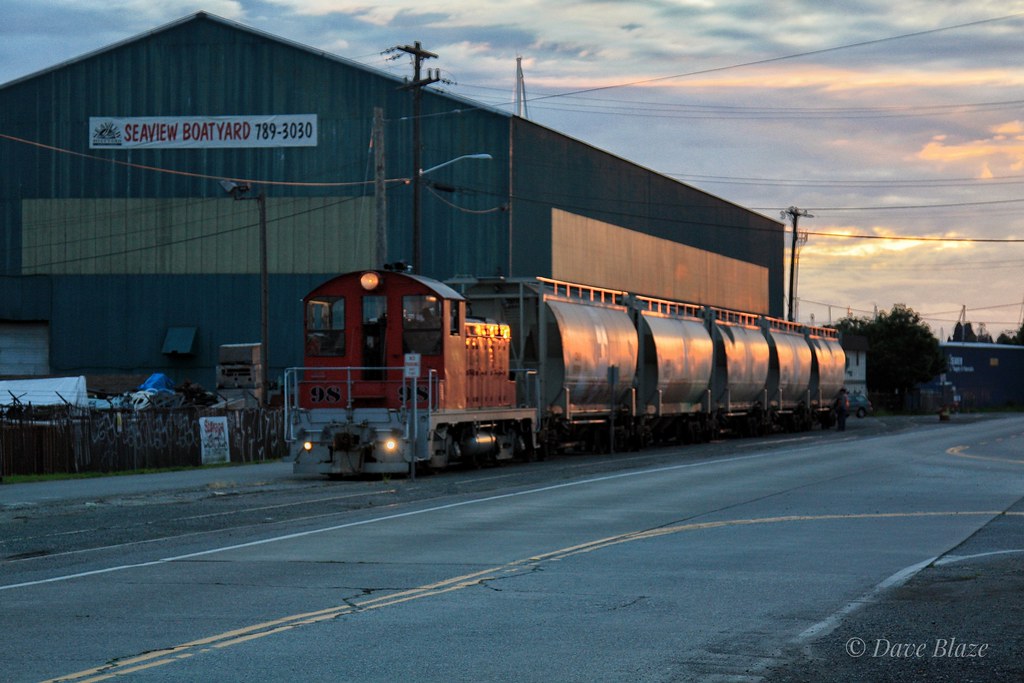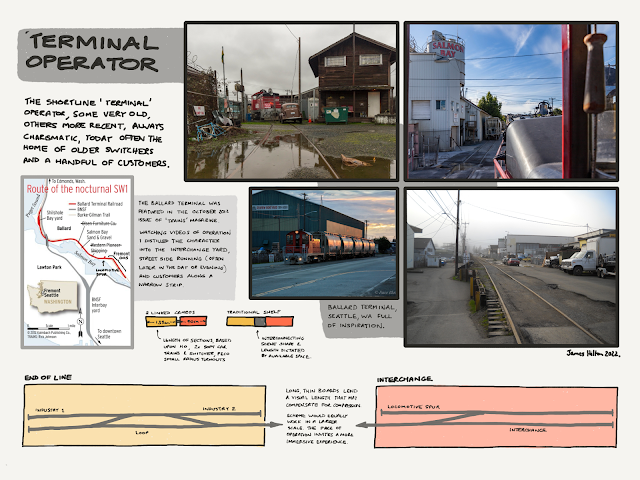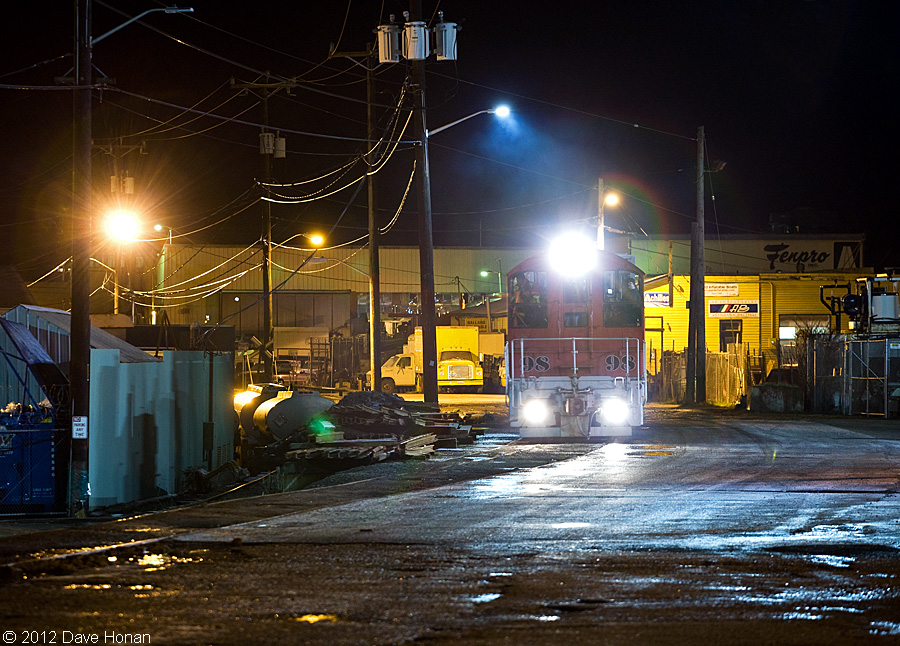Prototype parallels…
It struck me recently how much we have lost in the UK Railway landscape still exists in the North American one. I accept the political and geographical differences have shaped this extensively, this is not a lament, rather an observation…
Whilst watching a video about a tiny short line operating in Seattle, Washington, I found myself reaching for a copy of ‘The Wantage Tramway’ from the book shelf. Whilst the Ballard Terminal was only founded in 1997 of course the Wantage Tramway is long gone, but the former is a neat example of one of the newer short lines that popped up across the continent as the big freight operators (UP, BNSF, CSX, NS, CP, CN) looked to divest “last mile” operation as unprofitable, focusing instead on moving large trains from A to B, rather than assembly and disassembly of many smaller feeders. Ballard Terminal was formed by the last three customers on the line, however today is sustained only to provide incoming materials to Salmon Bay Sand and Gravel.
In contrast, opened in 1875, passenger service abandoned in 1925 (it became quicker and cheaper to travel by bus) and freight and closure in 1945, for 70 years the independent Wantage Tramway Company was a 2 mile feeder to the mighty Great Western linking the small town of ‘Wantage’ with the mainline at ‘Wantage Road’. Promoted and funded by local interests, it’s construction allowed businesses in Wantage to provide their goods and services with the rest of the country. Focusing on the lines later years the main traffic was flour out and fuel (coal and oil) in. Typically 2-3 vans of flour were sent out per week from Clark’s Mill to customers across the country, certainly Huntley and Palmers, the biscuit manufacturer frequently in the 1930s records. Coal for domestic use as well as for the gas works kept the upper yard busy whilst incoming oil was supplied on a much less frequent basis to the Anglo-American company who had storage tanks in the lower yard (Nicholas De Courtais and Turner, 2017).
 |
| The Manning Wardle, near Wantage, June 1939 (Johnson, 2022) |
The parallels are obvious, only a few miles long, limited number of tired locomotives, wagon load traffic to only a small number of customers, roadside operation… the feeling of survival yet almost impending obsolescence (how long can the canal side shore line industries survive with increasing real estate prices - will ‘Salmon Bay sand and gravel’ become just another condo on the shore one day?) An added attraction of North American ‘short line’ modelling is the element of credible freelance. I often discover new and interesting routes and customer operated lines - so an element of ‘what if’ isn’t to much of a stretch of the imagination. So whilst many have successfully modelled the Wantage Tramway in the UK, what about a reminagined ‘Wantage Terminal’ in the USA?
 |
| Ballard Terminal, Seattle, June 2010 (Blazejewski, 2010) |
I think these modern shortlines are fascinating. As model railroaders and train fans we have a habit of being a bit myopic in our view of what could be a modern shortline. Sometimes only seeing their end of the ecosystem that is railroading.
In railways like the Ballard Terminal we see what that last mile is. On the Barrie-Collingwood it’s mostly serving Comet Chemicals and the nuance of shunting chemical tank cars; on the Claremont-Concord it was salt hoppers; or on CF Lanaudiere or today’s Esquimalt & Nanaimo it’s mostly moving propane (certainly propane and fertilizer, like on the E&N, is the backbone of my modern PEIR using the E&N as my template).
Let’s take the traffic from the Wantage Tramway (fuel and flour) and map this into a more contemporary US setting, and as Chris mentions, propane would be a great swap in for fuel. If we take flour as meaning a mill that gives us grain cars in and either air slide hoppers (for milled flour) or boxcars (bagged flour). Motive power is even easier, many of these prototypes use ex-mainline switchers! Pick up one you like the look of and patch out the original owners name and number, or take inspiration from many of the short lines out there and repaint the unit in your own fictional scheme. One thing is certain, you’ll only need one…
Considering the minimum amount of operation that might generate and sustain interest whilst the rest of the layout is developed what follows is a suggestion on the ‘minimum requirements’. I would hesitate in recommending these are stretched and enlarged too far, but certainly longer spurs and a third track at the interchange may allow 3 car trains and marginally complicate operation for the better. The danger of cramming in loads of industries and spurs would, I feel, detract from the nature of a run down roadside tramway that I am suggesting holds a lot of this characterful promise. Avoid the caricature with this subject, aim for a distillation of character instead. Carefully choreographed.
Why am I advocating a traditionally UK inspired modeller even entertains this scheme? I think a number of reasons spring to mind with the improvement in running of a two trucked US outline switcher over a tiny two axle steam locomotive quite obviously top of the pile. Building something similar with a Hornby W4 Peckett ‘stand in’ would be eminently possible but I suggest somewhat frustrating for the operator… 3 link couplings, short wheelbase and attempting slow speed operation would certainly test my patience. Compare that to what I am suggesting, whisper quiet smooth slow locomotives with plenty of character and Kadee couplings that can be used with magnets or a cocktail stock to uncouple yet look plausibly realistic. A North American ‘generic’ short line taking inspiration and design cues from a long defunct prototype from across the Atlantic is perhaps just the tonic you need to re-energise your own modelling? What other British prototypes could be re-imagined in a North American setting?
 |
| Ballard Terminal 98, SW1 at Salmon Bay Sand and Gravel (Honan, 2012) |
Developing the plan further, a compact scheme like this may allow alternative presentation styles. Can you imagine turning the lights off, letting the locomotives running lights and headlights illuminate the way as it picks it’s way along under the amber glow of street lighting, the throttle spooling up and down as you negotiate the poor quality track avoiding dumpsters and parked cars. The darkness of the room and low lighting, combined with the sound, a completely immersive experience.
Imagine making this so the model is lit this way all the time?
A plain black backdrop, then using a faded black to soften the edges of the modelled scene as you move away from the focal point so the modelled scene fades into the black backdrop and black fascia. You could even use that black fade to bisect scenes to divide them based on the part of the play that happens in each.
In a way wouldn’t this be a beautiful masterwork project to settle into? That finite collection of rolling stock made and remade/refined like Roy Link as his Crowsnest muse?
Roy’s book on the Crowsnest shows how one subject sustained his modelling throughout life with spectacular results full of character and mastery. Taking a similar approach would perhaps allow a simple scheme like this to become a lifetimes work. Reflecting on my own experience, choosing your subject to match the space available with your own interests is key, something that is perhaps out of your usual sphere of interest may allow you to practice different skills yet it may also flounder in uncertainty. Therefore considering your motivation versus your inspiration should also be a step on the armchair stage of modelling. Is the quantity or quality of inspiration sufficient to drive you towards completion?
Like many of our meandering conversations, the links to our previous conversations goes to show that Chris and I, like many of you, enjoy exploring layout design. What I think I hope we bring to the table is a measured consideration of a wholistic approach, recognising that many elements lead to a fulfilling project. If any of our rambling or plans lead you from the armchair to a physical project then I’d consider that a good measure of our collective work. Until next time, more soon…
References:
Blazejewski, D. (2010). Ballard’s Little Beaver. [online] Flickr. Available at: https://www.flickr.com/photos/151111185@N04/49789977467/ [Accessed 4 Jan. 2022].
Honan, D. (2012). BDTL 98 at Salmon Bay Sand & Gravel Co. [online] Flickr. Available at: https://www.flickr.com/photos/dwhonan/6992240375/ [Accessed 4 Jan. 2022].
Honan, D. (2012a). BDTL 98 - Ballard, WA. [online] Flickr. Available at: https://www.flickr.com/photos/dwhonan/6992240407/ [Accessed 4 Jan. 2022].
Johnson, P. (2022). THE WANTAGE TRAMWAY - Paul Johnson. [online] transportsofdelight.smugmug.com. Available at: https://transportsofdelight.smugmug.com/RAILWAYS/RALWAYS-EXCLUDED-FROM-THE-1923-GROUPING/THE-WANTAGE-TRAMWAY/i-QvdpkSC/A [Accessed 4 Jan. 2022].
Nicholas De Courtais and Turner, C. (2017). The Wantage Tramway. Bath: Wild Swan Books Ltd.




Wow. My local line makes the blog! I live 1 mile from the Ballard Terminal line and have watched its decline and rebirth over the last 10 years. We can hear the horn weekly as it moved the cement cars. I rode the engine once three years ago...in your picture of the engine parked next to the office is a rusty-looking 1940s car. This was built as a hot rod by the engineer and is his daily driver. The line was the mainline to Canada for the Great Northern starting in the early 1890s when the waterfront was filled with shingle mills that lasted into the 1960s. Now it's mostly boat industry and Salmon Bay Gravel. And yes, apartments are starting to fill in. Four companies took over the 2 miles of track and as you say it's now down to just one and a few years ago it looked like Salmon Bay would die out and take the railroad with it. Then came the big building boom around 2016 and Ballard Terminal woke back up. At first there would be a few cars parked around the Salmon Bay plant. Now it can be over a dozen along the line, parked at the interchange, along the remaining track at Salmon Bay Gravel or at the extreme east end of the line where there is a runaround. The track along Shilshole Avenue was 3 tracks with lots of crossovers to help switchers get around all the mill traffic to spot cars. The mainline is now made up of sections, snaking through crossovers with unused track all over. The tracks disappear under collected water and dirt kicked over it by the trucks and cars. Flange slots let me know the line recently was run. Also, when I rode in the cab an old problem occurred: cars parked on the track. The crew called the tow company 4-5 times to pull cars blocking them, in one case the owner running madly to stop things as his car was jacked up. He lost that fight. I also know a Conductor who worked the area in the early 1950s--they also had a problem with cars but would quietly pole them out of the way! Imagine coming out and finding a 2x4 dent in your door and the car pushed over three feet. If you want maps let me know.
ReplyDeleteThank you David, that’s so cool that you live so close! It seems a lovely little prototype for the space starved modeller, or perhaps even as I say, a study to take a part of a modellers lifetime modelling.
DeleteMy reflection here is that the parallel between modern lines like Ballard, and the old ‘light railway’ here in the UK may allow someone to reinvent the old in the new creating a freelance terminal railroad.
I’d like to consider a study on this project at some point, especially getting the look of the track buried in dirt. I think that might be tricky but rewarding in H0…
Oh, yes, I understood your reflection and do agree. Ballard Terminal is seductive and for me that came to be concentrated as heavily in the employee stories of the line and riding in L'il Beaver as anything else. How to capture that experience? As Roy did with Crowsnest, develop an elaborate backstory to hold the long-term interest in a very simple project--but rooted properly in the prototype experience. The credibility of the story held Roy's Crowsnest concept together long term through multiple iterations as much as his modeling did. And then there is the Ballard Terminal's track: the incredible wonky geometry and physical nature create so much interest as the line weaves a serpentine path through the three tracks of the original Great Northern main and spurs to reach into Salmon Bay Gravel. Track is central to the nature of the beast and is foremost in the minds of the crew actually navigating the mess. For a cameo based on this line or any "last mile" concept, I would urge the modeler to include navigating through functional and abandoned trackage will inject visual life into an otherwise simple shunting experience. It would be interesting to inject one of Gyles Flavel's radio controlled vehicles into the scene to add the moving of a car parked across the track impediment to slow operations and have the eye linger longer on the models!
DeleteI love the idea of this Daivd.
DeleteI think if I do take it a step further and suggest a more complete scheme I shall incorporate some of this track ‘story’ in the scenic treatment and plan. Chris recently suggested a great name for the generic scheme, the Wantage Ballard Street Railway, reimagining it as a former trolley route that’s seen better days and is now operated by a worn out third hand switcher…
This comment has been removed by the author.
DeleteRe-writing my reply to get closer to what I was thinking. There was a trolly nearby, and an interurban, too, the latter handling some freight a few blocks away. Both were gone by WWII and neither would've put down trackage as seen on Shilshole Avenue. For me the actual story and physical plant are so engaging and unusual I'd ask "Why dream something up?" You lose the essence of what makes the Ballard Terminal unique.
DeleteDave, because the post was about the parallels between Wantage and Ballard, and the opportunity to reimagine a British light railway cast in the mould of the Ballard Terminal…
DeleteHowever, I fully agree with your feelings and comments about the Ballard. I think you’re right about doing it justice, and ensuring that as much of it’s character is imbued in any scheme. From the track layout to its buried nature… you commented on seeing the flange marks in the dirt, letting you know that things had moved… I think that experiential reflection could be used to fuel a fantastic recreation of this characterful short line…
In fact I will endeavour to create something alongside this post to do he Ballard justice!
Another great post James. As a British rail fan living in the States I feel very fortunate to be able to visit, watch, and photograph the kinds of small-scale short line operations you describe. Some are vibrant profitable businesses while others feel one step from closure. I recently photographed the General Mills branch in Lodi CA - though not technically a short line (owned and operated by Union Pacific) it nevertheless falls under the status of a one customer line (General Mills) that is currently out of service due the closure of the mill. It may or may not reopen but as another British railfan friend pointed out we are very lucky to still be able to photograph the remains of the line while it lies in situ. He line runs along the road in a single stretch, runs through the back of suburban houses, has several spurs into the mill through some very pleasant and modelable (yep made up word) scenery, and includes a staging area/head shunt in a tree-lined meadow to assemble trains from the different spurs into the mill. This kind of railway scene - easily accessible, quirky, small scale - disappeared from the UK in the late 70s and earlier. I aware of how lucky I am to be able to access these scenes and regularly make trips to capture and memorialize them.
ReplyDeleteThanks, I’d like to take this one further with a more detailed scheme and some 3D sketches in time…
DeleteWhilst researching I found further fodder, as I’m sure we all do when browsing YouTube. The Lapeer Industrial (Rob’s done a plan for this, I had something simpler in H0 drawn up, I must finish it off, it’s more a US version of my interchange layout), the Portland and Vancouver Junction also have a natty liveried switcher and short operation. There is something about Ballard’s street running that paralleled the Wantage so beautifully though.